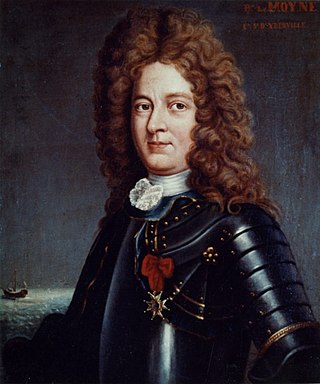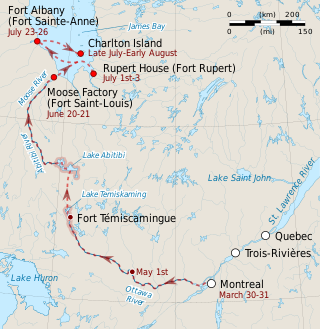
King William's War was the North American theater of the Nine Years' War (1688–1697), also known as the War of the Grand Alliance or the War of the League of Augsburg. It was the first of six colonial wars fought between New France and New England along with their respective Native allies before France ceded its remaining mainland territories in North America east of the Mississippi River in 1763.

Pierre Le Moyne d'Iberville or Sieur d'Iberville was a French soldier, explorer, colonial administrator, and trader. He is noted for founding the colony of Louisiana in New France. He was born in Montreal to French colonist parents.

York Factory was a settlement and Hudson's Bay Company (HBC) factory on the southwestern shore of Hudson Bay in northeastern Manitoba, Canada, at the mouth of the Hayes River, approximately 200 kilometres (120 mi) south-southeast of Churchill.

Jacques-René de Brisay, Marquis de Denonville was the Governor General of New France from 1685 to 1689 and was an important figure during the intermittent conflict between New France and the Iroquois known as the Beaver Wars.

Jean-Baptiste Le Moyne de Bienville, also known as Sieur de Bienville, was a French-Canadian colonial administrator in New France. Born in Montreal, he was an early governor of French Louisiana, appointed four separate times during 1701–1743. He was the younger brother of explorer Pierre Le Moyne d'Iberville.

The Pélican was a French warship from the late 17th century. Built in Bayonne, France, the original Pélican was launched in January 1693. A 500-ton ship fitted with 50 guns and commanded by Captain Pierre Le Moyne d'Iberville, she ran aground on the shores of Hudson Bay a few days after a heroic battle in 1697, badly damaged by the encounter and by a fierce storm. In five short months the ship's place in history had been assured, as the victor in the greatest naval battle in the history of New France.

The Battle of Hudson's Bay, also known as the Battle of York Factory, was a naval battle fought during the War of the Grand Alliance. The battle took place on 5 September 1697, when a French warship commanded by Captain Pierre Le Moyne d'Iberville defeated an English squadron commanded by Captain John Fletcher. As a result of this battle, the French took York Factory, a trading post of the Hudson's Bay Company.
Pierre de Troyes was a captain that led the French capture of Moose Factory, Rupert House, and Fort Albany on Hudson Bay 1686.
The Old Mobile Site was the location of the French settlement La Mobile and the associated Fort Louis de La Louisiane, in the French colony of New France in North America, from 1702 until 1712. The site is located in Le Moyne, Alabama, on the Mobile River in the Mobile-Tensaw River Delta. The settlement served as the capital of French Louisiana from 1702 until 1711, when the capital was relocated to the site of present-day Mobile, Alabama. The settlement was founded and originally governed by Pierre Le Moyne d'Iberville. Upon the death of d'Iberville, the settlement was governed by his younger brother, Jean-Baptiste Le Moyne de Bienville. The site can be considered a French counterpart to the English colonial settlement at Jamestown, Virginia. The settlement site and fort were listed on the National Register of Historic Places on May 6, 1976. The Old Mobile Site was determined eligible for designation as a National Historic Landmark on January 3, 2001.

Fort Maurepas, later known as Old Biloxi, was developed in colonial French Louisiana in April 1699 along the Gulf of Mexico . Fort Maurepas was designated temporarily as the capital of Louisiana in 1699. The capital was moved from Ocean Springs to Mobile in 1710, then to New Orleans in 1723 on the Mississippi River. Government buildings in the latter city were still under construction.
Pierre-Gabriel Marest was a French Jesuit missionary in Canada.
The Compagnie du Nord was a French colonial fur-trading company, founded in Québec City 1682 by a group of Canadien financiers with the express intent of competing with the English Hudson's Bay Company. It was founded by Charles Aubert de La Chesnaye with the assistance of Pierre-Esprit Radisson and his brother-in-law Médard Chouart des Groseilliers.

The Hudson Bay expedition of 1686 was one of the Anglo-French conflicts on Hudson Bay. It was the first of several expeditions sent from New France against the trading outposts of the Hudson's Bay Company in the southern reaches of Hudson Bay. Led by the Chevalier de Troyes, the expedition captured the outposts at Moose Factory, Rupert House, Fort Albany, and the company ship Craven.
The Battle of Fort Albany in 1693 was the successful recapture by English forces of the Hudson's Bay Company trading outpost at Fort Albany in the southern reaches of Hudson Bay. The fort, captured by a French expedition in 1686 and held by them in a battle the next year, was briefly defended by five Frenchmen, who then abandoned the fort and its stockpile of furs to a four-ship English fleet commanded by James Knight.

The Capture of York Factory was a 1694 Anglo-French conflict on Hudson Bay. In 1686. Pierre Le Moyne d'Iberville marched overland from Quebec City and captured all the trading posts of the English Hudson's Bay Company (HBC) on James Bay. This left York Factory, which was too far away and could only be reached by sea. In 1688 King William's War started and the needed ships were hard to get. In 1690 Iberville tried to take York Factory but was driven away by a larger English ship. In 1694, Governor Louis de Buade de Frontenac gave him the ships Salamandre and Poli. Iberville reached the Nelson River on 14 September. The fort was invested and on 14 October it surrendered..

The Battle of Fort Albany was an attack by French colonial volunteers and their native allies against the English Hudson's Bay Company outpost of Fort Albany in the southern reaches of Hudson Bay. About 70 Frenchmen and 30 Indians attacked the fort, which was under the command of John Fullartine. Fullartine's men repulsed the attack, killing eighteen attackers. He lost two men to ambush on their way back to the fort shortly after the attack.

The Avalon Peninsula campaign occurred during King William's War when forces of New France, led by Pierre Le Moyne d'Iberville and Governor Jacques-François de Monbeton de Brouillan, destroyed 23 English settlements along the coast of the Avalon Peninsula, Newfoundland in the span of three months. The campaign began with raiding Ferryland on November 10, 1696, and continued along the coast until they raided the village of Heart's Content.
Jacques Le Moyne de Sainte-Hélène was a Canadian soldier who was born on April 16, 1659, in Montréal. He was the son of Charles Le Moyne and Catherine Thierry. He died in Quebec City in 1690.

Fort Albany was a Hudson's Bay Company trading post established in 1679 near the site of the present day Fort Albany First Nation. The fort was one of the oldest and most important of the Hudson's Bay Company's posts. It was also involved in Anglo-French tensions leading to the Battle of Fort Albany in 1688.













